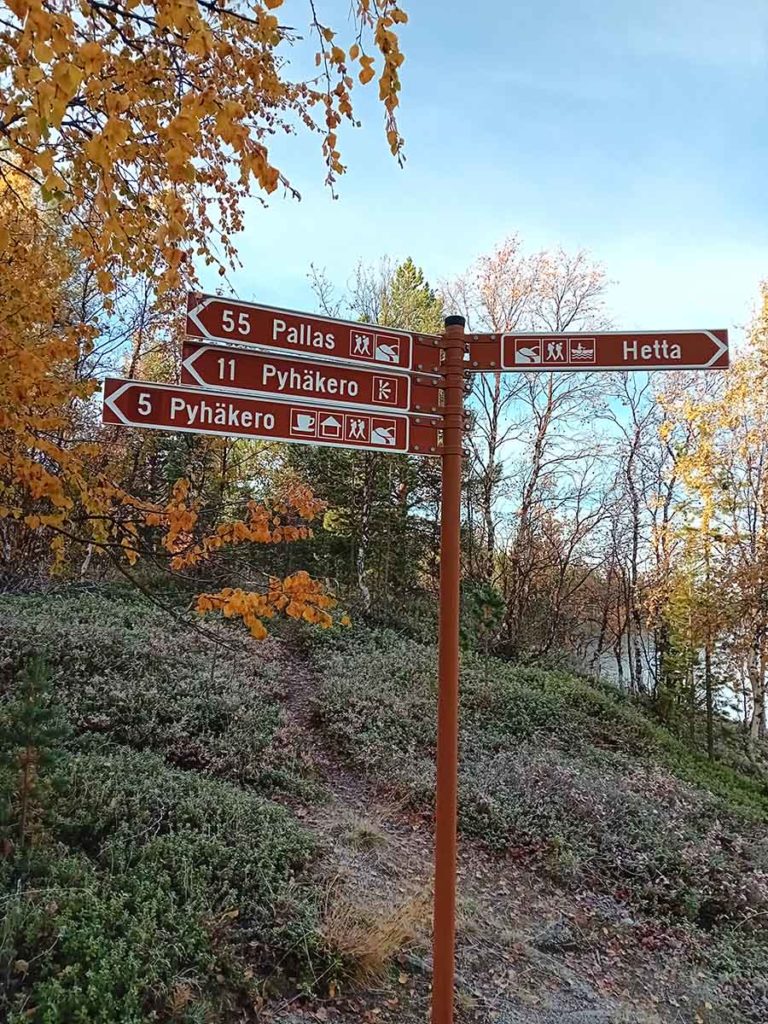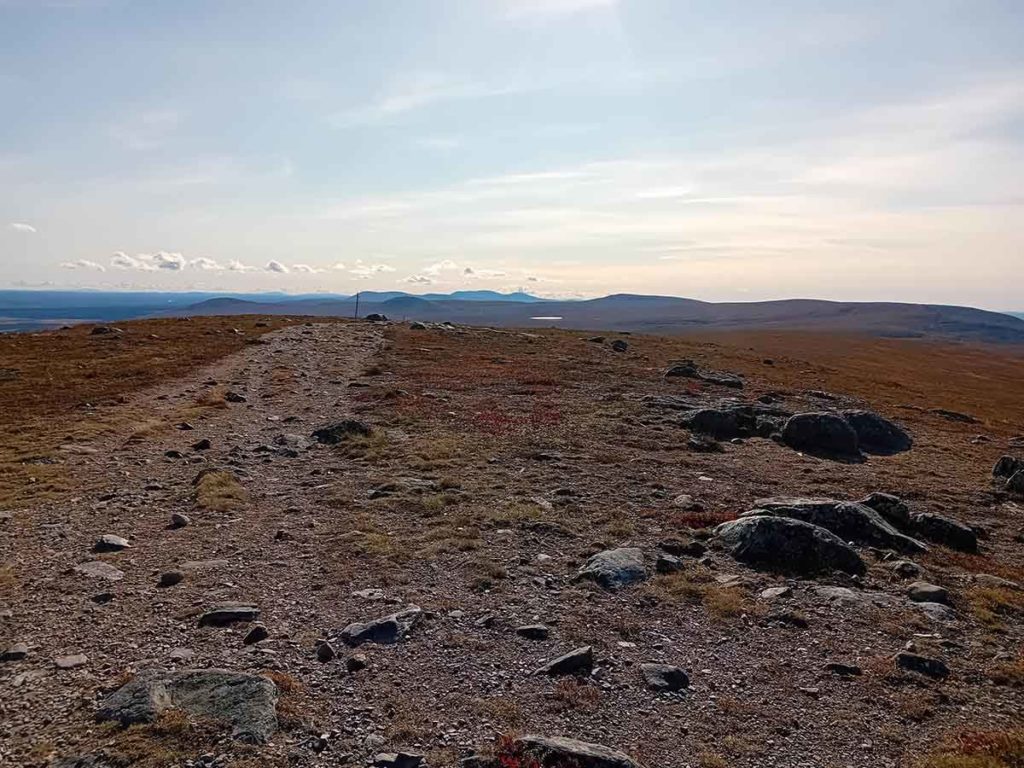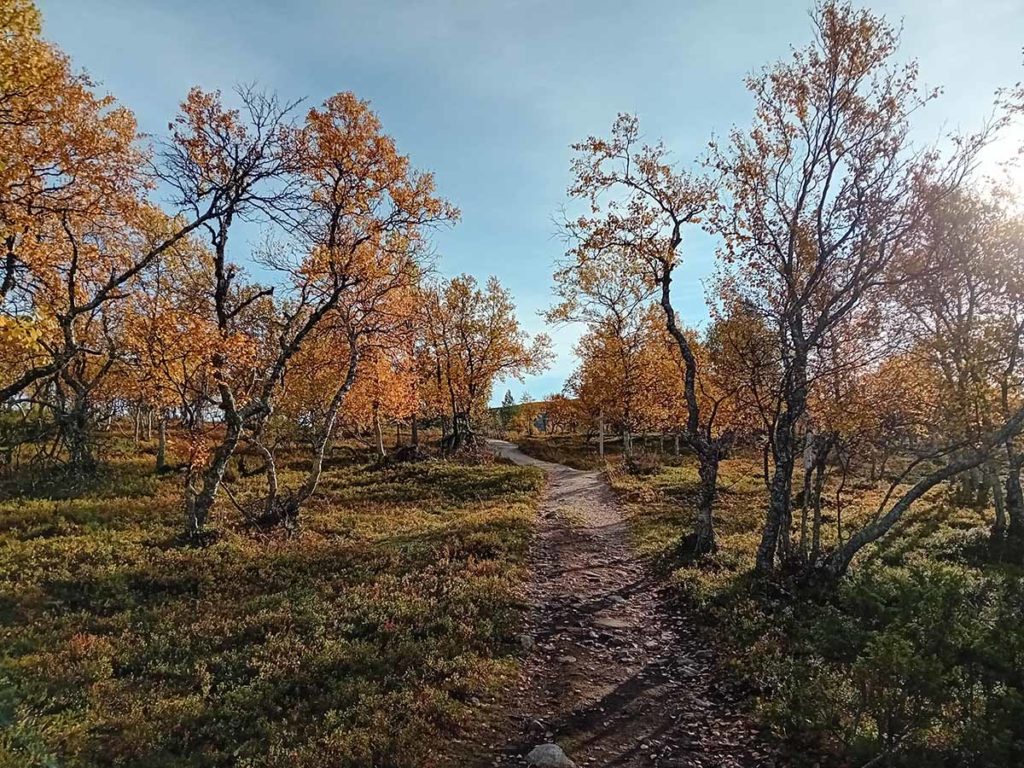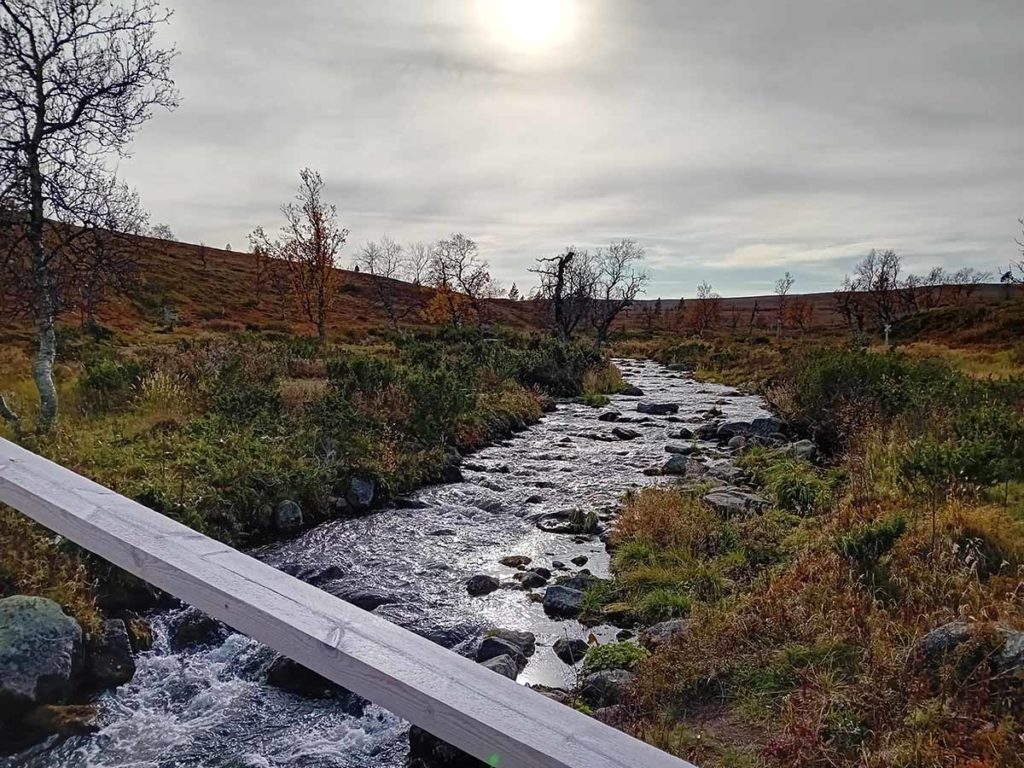What is the Hetta Pallas trail?
Founded in 1938, the Pallas-Yllästunturi National Park is the oldest national park in Finland, located in Lapland, at a border of great cultural significance to both Finns and the indigenous Sámi people who inhabited the region since the Stone Age around 12,000 years ago.
The Park boasts the purest air of anywhere in the world (https://discovermuonio.fi/en/thepurestair/) and the landscape is dominated by fells or “tunturi” which are the peaks of hills/mountains found in Fenno-Scandia which exist above the treeline. This gives them the peculiar barren look that defines the region.
The Hetta Pallas trail is the most popular hiking route in the park, and the route covered by this article.
Check out our comprehensive guide to the Northern Lights
How do you get there?

“The most common way to approach the route is to start in Hetta in Enotekiö and walk south to Pallas Visitor Centre near Muonio. So how do you get there?
By public transport:
First you’re going to have to get to either the city of Oulu or Rovaniemi (both accessible by train or plane from Helsinki). From here you can take a bus that will bring you to the village of Hetta but note there is only one bus daily (matkahuolto.fi).
By car:
Again, travelling by car from Oulu, you take the E8 motorway north to Enotekiö (via Tornio, Kolari and Muonio). From there you can avail of a service that will drive your car to Pallas Visitor Centre for you and be there on your arrival, though I would recommend driving to Pallas Visitor Centre on the same route but turning off onto Route 79 at Muonio and leaving your car there and getting a bus to Hetta (12:30 pm daily), as the bus is considerably cheaper than the cost of the car moving service.
From Rovaniemi the route is largely similar except you start by taking Route 83 to Pello where you join up with the E8 motorway and continue as specified earlier.
What to bring?
- 65L – 85L Bag
- Good quality hiking boots
- Rain coat
- Sleeping bag & sleeping mat
- A pot and spring cooker
- Re-fillable plastic drinking bottle
- Spork and bowl
- Sharp knife
- First aid kit (with lots of band-aids)
- Light waterproof shoes i.e. crocs
- Hiking pants
- Jacket
- Long sleeve t-shirt
- Under armour
- Fleece
- Hat and gloves
- 3 pairs of socks
- Towel
- Toilet paper
- Matches in waterproof bag
- Sponge and washing up liquid
- Food (as discussed later)
The Hetta Pallas trail
Hetta Pallas Trail: Day one

Day one began with a boat ride across Ounasjärvi courtesy of B&B we stayed at the night before Hetan Kota (https://hetankota.joikubooking.com/fi) followed by a quite unstrenuous stroll through deciduous forest of half a hundred hues of orange, red and yellow. In the crisp morning air spirits were high.
The gentle pathway eventually gave way to our first big ascent of the route, a 300 metre climb that, while not overly difficult, definitely got the heart rate up. This climb was also where we spotted our first herd of reindeer. With September being mating season, we had been warned not to approach but they were still nice to watch from a distance.
On the other side of the peak was our first hut where we stopped for lunch at Sioskuru, after which the route became a comfortable walk through rolling hills, high above the tree line and provided some of the best panoramic views of the entire trip.
We stayed the night in Pahakuru, having walked 27km that day which completely over shot our stated target of 15km for day one.

Hetta Pallas Trail: Day two

Day two began with a sharp descent followed by a trek through thick forest again, here the paths were all roots and rocks and with rain the previous night and some showers in the morning, the going was slower but the mist in the morning gloom gave the forest a very mystical quality.
After lunch in Suaskuru, the ascent began again immediately into a sharp incline, followed by another and then another as we climbed to the top of Lumikero. This was a constant stream of false peaks which every time you reached what you thought was the top, you were sadly mistaken and the mist did nothing to help either.
Down the other side of the mountain and then back up another, more gentle hill was probably the toughest part of the journey, the rocky paths awash with puddles made choosing your route tricky and one had to be constantly thinking about where to put your feet but eventually the rain let up and made our destination for the day.

Upon discovering the sleeping hut Nammalakuru to be full, we pressed on an extra three kilometres to a hut called Rihmakuru, a hut mainly used for eating but can be slept in if necessary. The “eating huts” being different from the “sleeping huts” in that they have single glazed windows and are not insulated as comprehensively.
Hetta Pallas Trail: Day three

Day three was yet another day of constant ascent however after a rocky start, something resembling a pathway opens up and makes things a bit easier. This culminates in the highest point of the journey at 757 metres above sea level. I am told that the views from up here are stunning, however, we did not get to enjoy such views as we were surrounded by mist as the rain poured down. But with our goal so nearly in sight, a little rain wasn’t going to dampen our spirits.
As we made our final, very gentle descent, we happened across our second herd of reindeer, this time they were very close to the path which really was a highlight of the trip and was the perfect way to round off an incredible three days.
Helpful tips
Plan your meals (including snacks) – This will help with weight management. We opted for “Summit to Eat” dinners which were very light to carry but filling. For breakfast we ate Porridge with peanut butter and for lunch we had ramen noodles. All light, dry foods that just require adding hot water.
In addition to this we brought dried fruit and nuts, as well as enough chocolate to make Willy Wonka jealous.
Bring a tent in case the huts are full and book for big groups – Though the trail is marked with huts intended for weary travellers to sleep in, you may find them full on your arrival so make sure you bring a tent just in case, especially if you are going during a busy season.
The huts are intended for individuals and small groups so if you are travelling with a larger group you are required to book a private hut in advance or bring your own tents.
Respect your fellow hikers – The huts you sleep or eat in have some rules to ensure fairness to all hikers, these include a “last in, last out” policy, no littering and where to wash or clean your dishes. Please respect these rules as well as your fellow travellers.
Do a test hike – Do a short test hike a week or two before to see what is or is not needed. My girlfriend and I did this and found it helpful though I did not heed my own warning. My hiking boots weren’t very comfortable on the test hike and this resulted in many blisters when it came to the real thing. Which leads to another point: good footwear is essential!
Always colder than you expect – No matter the temperature in Helsinki or Oulu when you arrive, it’s guaranteed to be a few degrees lower on the route. For example, it was 15 degrees celsius in Oulu the day before we left for Hetta, and about 8 degrees on our arrival.
Always bring a spare sweater or fleece to put on when you take a break as no matter how warm you are walking you cool down very quickly, especially when the wind gets up.”
When to walk the Hetta Pallas trail?

According to nationalparks.fi, the season for the Hetta Pallas trail runs from about the 20th of June to Mid-October with each part of the season having its pros and cons.
June/July/August – These are the warmest months however this means mosquitos are a big problem. If you are someone who can’t stand to be bitten, the best to give these months a skip.
September – We went in mid-September for what is the most popular part of the season as “Ruska” takes place, which is when the vegetation changes colour and turns the many hues of yellow, orange and red. However, this results in more people on the route and means less chance of space in the sleeping huts.
October – If you are brave enough to tackle the lower temperatures and less hours of daylight you will be treated to a solace that this route really deserves and will have the huts mostly to yourself. Although this will mean carrying extra warm clothes and therefore more weight in your backpack.
Images and words Odhran Brennan

